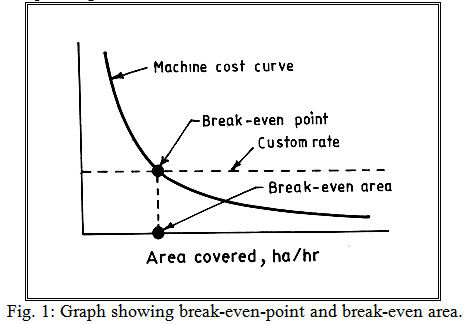Site pages
Current course
Participants
General
Module 1. Role of mechanization and its relationsh...
Module 2. Performance and power analysis
Module 3. Cost analysis of machinery- fixed cost a...
Module 4. Selection of optimum machinery and repla...
Module 5. Break-even point and its analysis, relia...
Module 6. Mechanization planning
Module 7. Case studies and agricultural mechanizat...
Topic 8
Topic 9
Topic 10
Lesson 21. Break-even point in mechanizing farm operations
Hiring custom operators is one important alternative to owing machinery. In some cases, using custom operators provides faster completion of work provides the least-cost method and does not require the capital needed for owing a machine. But when considering hiring a custom operator, do not forget timeliness of operations. Waiting for a custom operator to arrive is expensive in terms of timeliness, if it means not getting crops planted or harvested at the optimum time. Always consider timeliness in making a decision to use either a custom operator or an alternative method.
Determining when to use a custom operator is one of the most important decisions made in machinery management. To take a decision in this regard, the knowledge of break-even-use of a farm machine is a must. The break-even-use is the amount of use where the cost of using a machine owned would be the same as the cost of hiring a machine (Fig. 1). If a machine were used for less than the break-even-use, custom rate would be profitable. Otherwise owning a machine would be profitable.
Break-even-use can be determined by the following formula:

Where,
BEU = Break-even-use, ha
AOC = Annual ownership cost (fixed cost), Rs
CR = Custom rate, Rs/ha
OPC = Operating costs, Rs/ha

Example : In continuation of previous example, find the break-even-use of the mould board plough, if the custom rate is Rs.1400/ ha.
Solution :
Using the above equation

Annual fixed cost for mould board plough = Rs 10.95/h
Annual use of mould board plough = 200 h
AOC = 10.95 x 200 = Rs 2190.00
OPC = Rs. 1233.00/ha
Therefore,

Since custom rate is more than the operating cost of owned plough, so it is better to own the mould board plough rather then using on custom hire. Cost of owning the plough would be recovered after 13.1 ha of use.